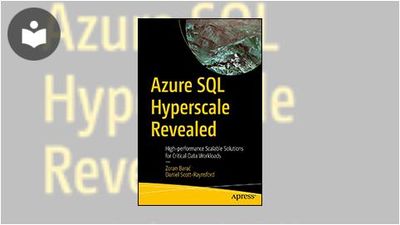Azure SQL Hyperscale Revealed: High-performance Scalable Solutions for Critical Data Workloads
- 4h 28m
- Daniel Scott-Raynsford, Zoran Barać
- Apress
- 2023
Take a deep dive into the Azure SQL Database Hyperscale Service Tier and discover a new form of cloud architecture from Microsoft that supports massive databases. The new horizontally scalable architecture, formerly code-named Socrates, allows you to decouple compute nodes from storage layers. This radically different approach dramatically increases the scalability of the service. This book shows you how to leverage Hyperscale to provide next-level scalability, high throughput, and fast performance from large databases in your environment.
The book begins by showing how Hyperscale helps you eliminate many of the problems of traditional high-availability and disaster recovery architecture. You’ll learn how Hyperscale overcomes storage capacity limitations and issues with scale-up times and costs. With Hyperscale, your costs do not increase linearly with database size and you can manage more data than ever at a lower cost.
The book teaches you how to deploy, configure, and monitor an Azure SQL Hyperscale database in a production environment. The book also covers migrating your current workloads from traditional architecture to Azure SQL Hyperscale.
What You Will Learn
- Understand the advantages of Hyperscale over traditional architecture
- Deploy a Hyperscale database on the Azure cloud (interactively and with code)
- Configure the advanced features of the Hyperscale database tier
- Monitor and scale database performance to suit your needs
- Back up and restore your Azure SQL Hyperscale databases
- Implement disaster recovery and failover capability
- Compare performance of Hyperscale vs traditional architecture
- Migrate existing databases to the Hyperscale service tier
Who This Book Is For
SQL architects, data engineers, and DBAs who want the most efficient and cost-effective cloud technologies to run their critical data workloads, and those seeking rapid scalability and high performance and throughput while utilizing large databases
About the Author
Zoran Barać is a cloud architect and data specialist with more than 15 years of hands-on experience in data optimization, administration, and architecture. He is a Certified Microsoft Trainer (MCT) and Microsoft Certified Solutions Expert (MCSE) with a master‘s degree in Information Technology. Sharing knowledge and contributing to the SQL Server community is his passion. He is also an organizer of the Auckland SQL User Meetup Group, an active blogger, and speaker at different SQL events such as Data Summits, SQL Saturdays, SQL Fridays, Meetups, etc.
Daniel Scott-Raynsford is a Partner Technology Strategist at Microsoft with 15 years of experience as a software developer and solution architect. He specializes in DevOps and continuous delivery practices. He was a Microsoft MVP in Cloud and Datacenter Management for three years before joining Microsoft and is an active PowerShell open source contributor and Microsoft DSC Community Committee member. He is also a contributor to the Azure Architecture Center on multi-tenant architecture practices.
In this Book
-
Introduction
-
The Journey to Hyperscale Architecture in Azure SQL
-
Azure SQL Hyperscale Architecture Concepts and Foundations
-
Planning an Azure SQL DB Hyperscale Environment
-
Deploying a Highly Available Hyperscale Database into a Virtual Network
-
Administering a Hyperscale Database in a Virtual Network in the Azure Portal
-
Configuring Transparent Data Encryption to Bring Your Own Key
-
Enabling Geo-replication for Disaster Recovery
-
Configuring Security Features and Enabling Diagnostic and Audit Logs
-
Deploying Azure SQL DB Hyperscale Using PowerShell
-
Deploying Azure SQL DB Hyperscale Using Bash and Azure CLI
-
Deploying Azure SQL DB Hyperscale Using Azure Bicep
-
Testing Hyperscale Database Performance Against Other Azure SQL Deployment Options
-
Monitoring and Scaling
-
Backup, Restore, and Disaster Recovery
-
Security and Updating
-
Managing Costs
-
Determining Whether Hyperscale Is Appropriate
-
Migrating to Hyperscale
-
Reverse Migrating Away from Hyperscale
-
Conclusion



